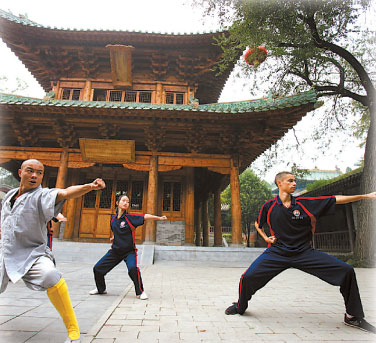The legend and legacy of Shaolin
 |
| Jeremy Landre (right) practises kungfu at Shaolin Temple in Dengfeng.Lu Zhongqiu |
For anyone who remembers the 1979 blockbuster Shaolin Temple starring a very young Jet Li, Songshan is where the adolescent monk resisted sexual temptations and channeled his energy into martial arts of the highest order. After all, this is a sacred place for kungfu masters and wannabes.
Jeremy has not seen the movie, but he saw a demonstration of a kungfu routine in his hometown at the tender age of 10, thus sowing the seeds of possibly a lifelong dream. "I want to be a kungfu master," he declared, "and make a living by opening a kungfu club in France - an authentic one."
He jetted to Shaolin and had a one-month stint at the temple-affiliated school. That did not quite whet his appetite. This year, he has come back for more - a year-long program of stricter and more systematic training. "I'm still a beginner. By the time I finish, I want to reach an intermediate level."
Like Jeremy Landre, hundreds of kungfu fans from outside China embark on a special pilgrimage to the temple and enroll themselves in various training programs. Youngsters from other parts of China harbor the same dream - that someday they will move with lightning speed, chopping and kicking with expert timing like Jackie Chan or Jet Li.
There are 83 martial arts schools in the county where the temple is situated that take a total of 53,000 students. The boulevard leading to the temple is lined with so many schools, every schoolyard filled with phalanxes of boys doing all kinds of stunts, that it looks like Zhang Yimou is shooting a kungfu epic of biblical proportions.
For the county of Dengfeng, martial arts education is not only a great business, but a great way to share the wealth of knowledge about a centuries-old heritage. Shaolin kungfu is more than physical strength and dexterity; it is about a way of life, a philosophy, about compassion and good prevailing over evil.
In an effort to capitalize on its fame, the temple authority has combined business and religion, yielding huge profits. Some have criticized them for over-commercialization.
First built in AD 496, Shaolin Temple developed its kungfu rituals from household chores such as sweeping the floor, carrying buckets of water and collecting firewood. Martial art skills were also born out of Zen practices.
By the early Tang Dynasty (AD618-907), the temple had trained monks into a fiercely combative army. Later, the warrior-monks helped the emperor in quelling a rebellion. From there, they got his majesty's license to kill, and of course to eat non-vegetarian food. The temple did not begin losing its luster until the Qing Dynasty (1644-1911).
For all the eye-catching kicks and punches, the rigor, discipline and monotony of kungfu can be a little less enticing. Jeremy and his classmates have to get up at five in the morning, go through the early morning practice from 5:30-6:30 am, have breakfast at 7am, attend the morning session from 8:30-11:30 am followed by lunch, then the afternoon session at 2:30-5:30 pm followed by dinner at 6pm, culminating in a one-hour language class in the evening.
Jeremy does not know where the nearest French restaurant is. "I don't miss French food." The school has customized menus for its foreign students and each meal includes two meat dishes and two vegetable dishes. On weekends, he heads for the county town, to do some shopping and chat online with his parents at an Internet caf.
To accommodate foreign students from 20-plus countries and aged as young as 9, the school has to tailor the program for each student. "Most who come here have not been exposed to Martial Arts 101," said Shi Hongfa, a trainer. "But they are eager to learn and are easy to communicate with because they tend to be outgoing."
For some of these students it's a wish upon the stars - movie stars - but most just want to be trainers of kungfu in their own countries. Jeremy Landre reveals his secret passion for fighting moves that simulate monkeys and tigers, or "drunken boxing", but he doesn't care for the movie business.
"Kungfu fighting on screen is not real. It's just to show off. I'm not interested in becoming an action star," he sneers. "I'd be willing to do it for the money, though."
(China Daily 10/19/2007 page25)














